„Orange juice bottles“ – Judgement of the Higher Regional Court of Hamburg
Attorney at Law | Certified
Intellectual Property Law Attorney
dated 31. August 2022, case-No. 5 U 60/22
The applicant No. 1 manufactures and sells bottled fruit juices, as can be seen from the illustration shown below:
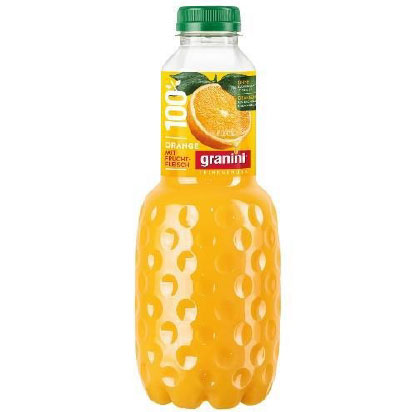
The design of the bottle (so-called “granini bootle”) dates back to 1969 and is based on the shape of a pineapple. The typical design of this bottle also includes indentations (so-called “dimples”), with which the nubs on the outside of the skin of a pineapple are stylised. The bottle is colourlessly transparent and therefore allows the colour of the respective fruit juice to be seen.
The applicant No. 2 is the parent company of the group and is, inter alia, the proprietor of the following German three-dimensional trade mark No. 302013028930, which claims protection for, inter alia, “fruit drinks and fruit juices”:
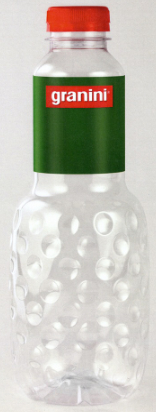
The respondents market the fruit bottles (hereinafter referred to as “albi bottles”) shown below:
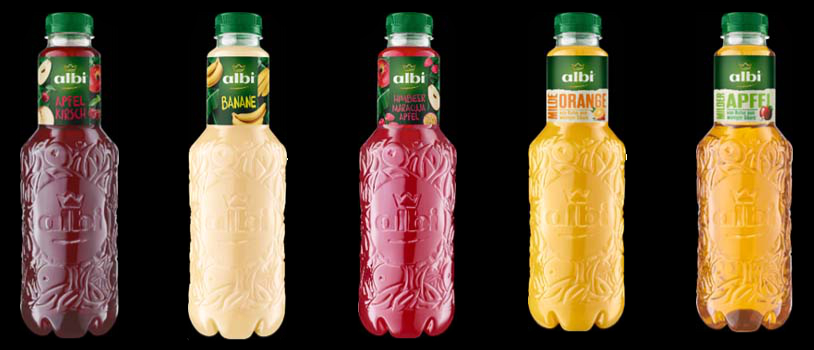
In their application for an interim injunction of 10 November 2021, the applicants had applied to the Hamburg Regional Court, inter alia, to prohibit the respondents from offering, selling, otherwise placing on the market and/or advertising fruit juices and fruit nectars in the Federal Republic of Germany which are presented as in the designs shown above.
The applicant No. 1 relied on claims under competition law and the applicant No. 2 relied primarily on claims under trade mark law and, in the alternative, on claims under Community design law.
The District Court of Hamburg granted the application for a preliminary injunction on 18 November 2021 and, upon the respondents’ opposition, confirmed the preliminary injunction by judgment of 13 January 2022. It assumed that the claim of the applicant No. 1 followed from protection of its performance under competition law and the claim for injunctive relief of the applicant No. 2 followed from infringement of the German trade mark no. 302013028930 (see above).
The appeal of the respondents to the Hamburg Higher Regional Court (OLG Hamburg) was successful.
The OLG is of the opinion that the applicants are neither entitled to the asserted claim for injunctive relief based on the protection of performance under competition law pursuant to Sect. 8 para. 1, para. 3 no. 1, Sect. 3, 4 no. 3 lit. (a) Competion Law (UWG) nor due to trademark infringement pursuant to Sect. 14 para. 2 sentence 1 no. 2, para. 5 German Trade Mark Act.
No injunctive relief pursuant to Sect. 8 para. 1, para. 3 no. 1, Sect. 3, 4 no. 3 lit. a Competiton Law (UWG) due to avoidable deception of origin:
In the opinion of the OLG Hamburg, the “albi bottles” shown above do not constitute an unfair imitation of the product design of the “granini bottle”.
The assumption of imitation within the meaning of Sec. 4 No. 3 UWG presupposes that the design elements adopted are precisely those which establish the competitive originality of the imitated product.
The applicants had argued that the basic concept of the “granini bottle”, unchanged since 1969, was characterised by the following product features:
- cylindrical bottle belly and plumb cylindrical bottle neck
- bottle belly and bottle neck approximately in the ratio 3:2
- strict visual separation between bottle belly and bottle neck, no “soft transition”
- wide screw cap, with minimal tapering at the neck of the bottle
- dimples in the belly of the bottle, reminiscent of the nubs on a pineapple
- the label is usually attached to the neck of the bottle to make the belly of the bottle with the dimples and the contents fully visible and undisturbed.
However, taking particular account of the “granini bottle” submitted by the applicants, the OLG Hamburg comes to a different assessment of the features characterising the overall impression of the bottle, namely the following:
- slightly bulbous bottle body with distinctly rounded top and bottom, featuring a multitude of regular round indentations;
- the regular round indentations create a grip-friendly feel because the indentations appear suitable for holding the fingertips;
- the bottle’s belly makes up about 2/3 of the total bottle;
- above the body of the bottle sits a much narrower cylindrical bottle neck that tapers towards the screw cap;
- wide screw cap;
- wide label on the neck of the bottle with the trade mark “granini”.
The overall impression of the “granini bottle” is enhanced by the body of the bottle, which makes up about 2/3 of the bottle and appears slightly conical (bulbous) due to its roundings, and is reminiscent of the body of a pineapple fruit. In addition, the indentations (so-called dimples) create a special, unusual feel because the bottle can be gripped comfortably through these indentations by forming recognisable hollows for the figner tips.
Compared to this peculiar design of the “granini bottle”, the “albi bottles” are neither an almost identical copy nor a copycat imitation. In particular, the “albi bottles” lack a rounded-looking bottle body with rounded indentations and therefore appear organic and bulbous. The contested bottles are rather cylindrical and straight. Moreover, the floral pattern of the “albi bottles” does not give the bottle body a rounded appearance and does not create a haptic impression of recessed grips. This is even clearer from the front view, where the trade mark ‘albi’ is embossed with a stylised crown and embedded in the floral design in the shape of a seal. There was nothing in the attacked designs to remind one of a pineapple, as the following juxtaposition shows:
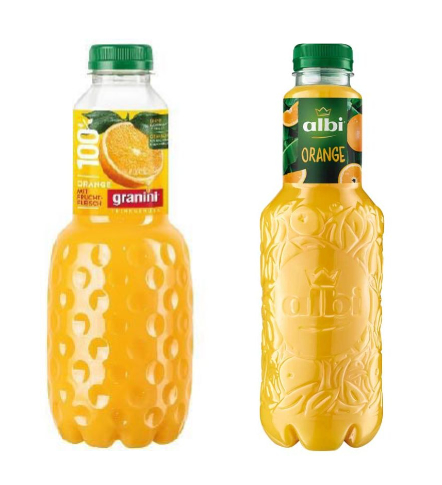
The only similarities between the two bottles were in the design of the top of the bottle with the lid, the surrounding drip protection, the base with modelled “feet”, the conical transition from the top of the bottle into the neck of the bottle and its conical transition into the body of the bottle, and the labelling of the neck of the bottle. However, these adopted design features were not those that constituted the competitive originality of the “granini bottles” for which protection was sought.
In addition, the contested bottles with the sign ‘albi’ have a different and long-standing manufacturer’s identification on the market, namely, in particular as shown below:
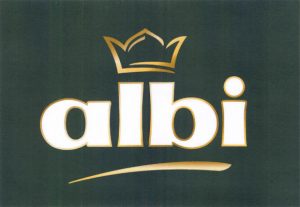
which is both applied to the banderole on the neck of the bottle and embossed in the belly of the bottle.
According to the case law of the Federal Court of Justice, a different manufacturer’s identification is in principle suitable to counteract a deception of origin. In this context, it was only the recognisability of the deviating manufacturer’s identification in the purchase situation that mattered. This was to be affirmed in the present case. Moreover, such a different manufacturer’s identification was particularly suitable for differentiation if – as in this case – the product design itself is not an imitation.
Moreover, no deception of origin in the broader sense was to be affirmed. A deception of origin would only exist if the public were to believe that the imitation was a new series or a product of the original manufacturer marketed under a secondary brand or if it were to assume that there were business relationships between the parties involved, such as licensing or shareholder agreements.
The respondents previously had the applicant’s “granini bottles” in their assortment of products and now no longer have these but the “albi juices” in their assortment. However, according to the OLG Hamburg, this was not sufficient to be able to assume that the “albi bottles” could be a secondary brand of the previous “granini” juices. Rather, a “genuine” change of supplier must be assumed.
Trade mark claims as well as the alternatively asserted claims under Community design law are also to be excluded for the reasons already explained above.
Comment
The decision of the Higher Regional Court of Hamburg once again makes it clear that before asserting claims under competition law, trade mark law and design law, it must be examined in detail which features of the intellectual property right from which action is to be taken characterise the overall impression of this intellectual property right and whether these have been taken over from the product to be challenged or whether the coinciding features are merely those which are customary in the market and which precisely do not constitute the overall impression of the intellectual property right of the plaintiff / applicant.
Furthermore, it should be examined whether a manufacturer’s identification visible in the product to be attacked can already lead to the exclusion of infringement claims.